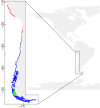A species distribution model of the giant kelp Macrocystis pyrifera: Worldwide changes and a focus on the Southeast Pacific
- PMID: 38435006
- PMCID: PMC10905252
- DOI: 10.1002/ece3.10901
A species distribution model of the giant kelp Macrocystis pyrifera: Worldwide changes and a focus on the Southeast Pacific
Abstract
Worldwide climate-driven shifts in the distribution of species is of special concern when it involves habitat-forming species. In the coastal environment, large Laminarian algae-kelps-form key coastal ecosystems that support complex and diverse food webs. Among kelps, Macrocystis pyrifera is the most widely distributed habitat-forming species and provides essential ecosystem services. This study aimed to establish the main drivers of future distributional changes on a global scale and use them to predict future habitat suitability. Using species distribution models (SDM), we examined the changes in global distribution of M. pyrifera under different emission scenarios with a focus on the Southeast Pacific shores. To constrain the drivers of our simulations to the most important factors controlling kelp forest distribution across spatial scales, we explored a suite of environmental variables and validated the predictions derived from the SDMs. Minimum sea surface temperature was the single most important variable explaining the global distribution of suitable habitat for M. pyrifera. Under different climate change scenarios, we always observed a decrease of suitable habitat at low latitudes, while an increase was detected in other regions, mostly at high latitudes. Along the Southeast Pacific, we observed an upper range contraction of -17.08° S of latitude for 2090-2100 under the RCP8.5 scenario, implying a loss of habitat suitability throughout the coast of Peru and poleward to -27.83° S in Chile. Along the area of Northern Chile where a complete habitat loss is predicted by our model, natural stands are under heavy exploitation. The loss of habitat suitability will take place worldwide: Significant impacts on marine biodiversity and ecosystem functioning are likely. Furthermore, changes in habitat suitability are a harbinger of massive impacts in the socio-ecological systems of the Southeast Pacific.
Keywords: Southeast Pacific; climate change; distribution model; habitat forming; kelp forests; projection.
© 2024 The Authors. Ecology and Evolution published by John Wiley & Sons Ltd.
Conflict of interest statement
The authors declare that they have no conflict of interest.
Figures




Similar articles
-
Standing Crop, Turnover, and Production Dynamics of Macrocystis pyrifera and Understory Species Hedophyllum nigripes and Neoagarum fimbriatum in High Latitude Giant Kelp Forests.J Phycol. 2022 Dec;58(6):773-788. doi: 10.1111/jpy.13291. Epub 2022 Nov 17. J Phycol. 2022. PMID: 36302142 Free PMC article.
-
Drivers of spatiotemporal variability in a marine foundation species.Ecol Appl. 2025 Jan;35(1):e3092. doi: 10.1002/eap.3092. Ecol Appl. 2025. PMID: 39957275 Free PMC article.
-
Past climate-driven range shifts structuring intraspecific biodiversity levels of the giant kelp (Macrocystis pyrifera) at global scales.Sci Rep. 2023 Jul 25;13(1):12046. doi: 10.1038/s41598-023-38944-7. Sci Rep. 2023. PMID: 37491385 Free PMC article.
-
Wave damping by giant kelp, Macrocystis pyrifera.Ann Bot. 2024 Mar 8;133(1):29-40. doi: 10.1093/aob/mcad094. Ann Bot. 2024. PMID: 37463436 Free PMC article.
-
Shrinking suitable habitat of a sub-Arctic foundation kelp under future climate scenarios.J Phycol. 2024 Oct;60(5):1319-1331. doi: 10.1111/jpy.13493. Epub 2024 Sep 17. J Phycol. 2024. PMID: 39287914
Cited by
-
An Environmental Niche Exploration Tool for Kelp Forest Management.Ecol Evol. 2025 May 28;15(6):e71459. doi: 10.1002/ece3.71459. eCollection 2025 Jun. Ecol Evol. 2025. PMID: 40454217 Free PMC article.
References
-
- Aguilera, M. A. , Aburto, J. A. , Bravo, L. , Broitman, B. R. , García, R. A. , Gaymer, C. F. , Gelcich, S. , López, B. A. , Montecino, V. , Pauchard, A. , Ramos, M. , Rutllant, J. A. , Sáez, C. A. , Valdivia, N. , & Thiel, M. (2019). World Seas: An environmental evaluation. (pp. 673–702). Chile: Environmental status and future perspectives.
-
- Arntz, W. E. , & Tarazona, J. (1990). Effects of el niño 1982–83 on benthos, fish and fisheries off the South American Pacific coast. Elsevier Oceanography Series, 52, 323–360.
-
- Assis, J. , Alberto, F. , Macaya, E. C. , Castilho Coelho, N. , Faugeron, S. , Pearson, G. A. , Ladah, L. , Reed, D. C. , Raimondi, P. , Mansilla, A. , Brickle, P. , Zuccarello, G. C. , & Serrão, E. A. (2023). Past climate‐driven range shifts structuring intraspecific biodiversity levels of the giant kelp (Macrocystis pyrifera) at global scales. Scientific Reports, 13(1), 12046. - PMC - PubMed
-
- Assis, J. , Araújo, M. B. , & Serrão, E. A. (2018). Projected climate changes threaten ancient refugia of kelp forests in the North Atlantic. Global Change Biology, 24(1), e55–e66. - PubMed
LinkOut - more resources
Full Text Sources
Other Literature Sources
Research Materials

